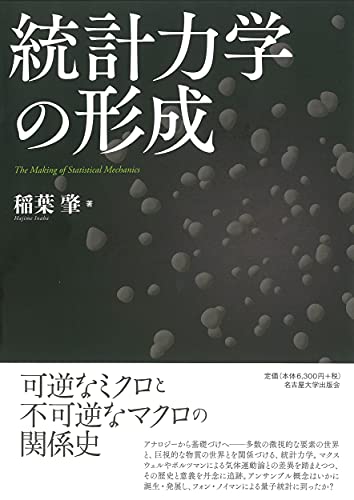23 0 0 0 20世紀物理学史 : 理論・実験・社会
- 著者
- ヘリガ・カーオ著 有賀暢廸 稲葉肇他訳
- 出版者
- 名古屋大学出版会
- 巻号頁・発行日
- 2015
11 0 0 0 量子力学の観測問題に取り組んだ神父――柳瀬睦男の経歴と業績
- 著者
- 稲葉 肇
- 出版者
- 一般社団法人 日本物理学会
- 雑誌
- 日本物理学会誌 (ISSN:00290181)
- 巻号頁・発行日
- vol.74, no.11, pp.792-794, 2019-11-05 (Released:2020-05-15)
- 参考文献数
- 22
歴史の小径量子力学の観測問題に取り組んだ神父――柳瀬睦男の経歴と業績
10 0 0 0 OA <一般論文> アンサンブル理論と熱力学的アナロジーの系譜 : ギブスの統計力学についての一考察
- 著者
- 稲葉 肇
- 出版者
- 京都大学文学部科学哲学科学史研究室
- 雑誌
- 科学哲学科学史研究 (ISSN:18839177)
- 巻号頁・発行日
- vol.8, pp.1-20, 2014-03-31
This paper shows that JosiahWillard Gibbs (1839–1903) integrated Helmholtzian thermodynamic analogies with the Boltzmann-Maxwellian ensemble approach in his book Elementary principles in statistical mechanics (1902). On one hand, Gibbs took over the ensemble concept from Maxwell and Boltzmann, who developed it in the 1870s and 1880s. A lecture note taken by a Gibbs' student reveals that Gibbs finished his theory of statistical mechanics following the Boltzmann-Maxwell line almost completely by 1895. On the other hand, Gibbs made analogies with thermodynamics in Helmholtz's sense; in 1884 Helmholtz suggested the idea of monocyclic systems to establish the fact that there are formal and operational correspondences between mechanics and thermodynamics. In the same year, Boltzmann extended the domain of monocyclic systems by means of ensembles, but he made only formal analogies. The lecture note also mentions formal analogies. In the Elementary principles, Gibbs applied the ensemble concept to make both formal and operational analogies, as can be seen in Helmholtz. Although there is no direct evidence that Gibbs studied Helmholtz's monocyclic systems, a detailed analysis allows us to interpret Gibbs' theory as succeeding Helmholtz' thermodynamic analogies.
- 著者
- 稲葉 肇
- 出版者
- 京都大学文学部科学哲学科学史研究室
- 雑誌
- 科学哲学科学史研究 (ISSN:18839177)
- 巻号頁・発行日
- vol.6, pp.109-113, 2012-02-28
- 著者
- 稲葉 肇
- 出版者
- 京都大学文学部科学哲学科学史研究室
- 雑誌
- 科学哲学科学史研究 (ISSN:18839177)
- 巻号頁・発行日
- vol.8, pp.1-20, 2014-03-31
This paper shows that JosiahWillard Gibbs (1839–1903) integrated Helmholtzian thermodynamic analogies with the Boltzmann-Maxwellian ensemble approach in his book Elementary principles in statistical mechanics (1902). On one hand, Gibbs took over the ensemble concept from Maxwell and Boltzmann, who developed it in the 1870s and 1880s. A lecture note taken by a Gibbs' student reveals that Gibbs finished his theory of statistical mechanics following the Boltzmann-Maxwell line almost completely by 1895. On the other hand, Gibbs made analogies with thermodynamics in Helmholtz's sense; in 1884 Helmholtz suggested the idea of monocyclic systems to establish the fact that there are formal and operational correspondences between mechanics and thermodynamics. In the same year, Boltzmann extended the domain of monocyclic systems by means of ensembles, but he made only formal analogies. The lecture note also mentions formal analogies. In the Elementary principles, Gibbs applied the ensemble concept to make both formal and operational analogies, as can be seen in Helmholtz. Although there is no direct evidence that Gibbs studied Helmholtz's monocyclic systems, a detailed analysis allows us to interpret Gibbs' theory as succeeding Helmholtz' thermodynamic analogies.
2 0 0 0 OA <翻訳> L・ボルツマン 力学の諸原理について
- 著者
- 稲葉 肇
- 出版者
- 京都大学文学部科学哲学科学史研究室
- 雑誌
- 科学哲学科学史研究 (ISSN:18839177)
- 巻号頁・発行日
- vol.6, pp.121-150, 2012-02-28
1 0 0 0 OA ギブスの熱力学と統計力学 : 物理化学の視点から
- 著者
- 稲葉 肇
- 出版者
- 日本科学史学会
- 雑誌
- 科学史研究 (ISSN:21887535)
- 巻号頁・発行日
- vol.49, no.253, pp.1-10, 2010 (Released:2021-08-02)
This paper reveals that Josiah Willard Gibbs (1839-1903) attempted to explain certain chemical properties of matter, such as osmotic pressure of "diaphragms" (semi-permeable membranes) and electromotive force of chemical cells, from his theory of statistical mechanics, i.e., Elementary Principles in Statistical Mechanics (1902; EPSM). To begin with, I examine his thermodynamical theory developed in "On the Equilibrium of Heterogeneous Substances" (1876/78; EHS). Later, I attempt to support the above claim by analyzing his theory of statistical mechanics. In EHS and his later discussions on thermodynamics, Gibbs used thermodynamics to derive various properties of matter in equilibrium. Among others, "the fundamental equations" of thermodynamics and different "conditions of equilibrium," for both of which temperature, pressure and chemical potentials were essential, played a pivotal role in explaining these properties. With these two means, Gibbs explained a wide range of physicochemical phenomena such as diaphragms and chemical cells. In EPSM, Gibbs argued that some properties of ensembles corresponding to those of thermodynamical systems can be derived. I focus, in particular, on the properties of grand canonical ensembles, because he used them to deduce a formula analogical to one of the fundamental equations of thermodynamics, and to construct an analog of a diaphragm with corresponding conditions of equilibrium. Further, he included problems of chemical cells in the scope of statistical mechanics. Therefore, Gibbs' theory of statistical mechanics can be considered as a theory that attempted to explain the physicochemical domain.
1 0 0 0 編集後記
- 著者
- 稲葉 肇
- 出版者
- 一般社団法人 日本物理学会
- 雑誌
- 日本物理学会誌 (ISSN:00290181)
- 巻号頁・発行日
- vol.77, no.6, pp.406-407, 2022-06-05 (Released:2022-06-05)
編集後記
1 0 0 0 IR <翻訳> L・ボルツマン 力学の諸原理について
- 著者
- 稲葉 肇
- 出版者
- 京都大学文学部科学哲学科学史研究室
- 雑誌
- 科学哲学科学史研究 (ISSN:18839177)
- 巻号頁・発行日
- no.6, pp.121-150, 2012-02-28
1 0 0 0 OA ファナック・ロボット学校
- 著者
- 稲葉 肇 小島 利夫
- 出版者
- 日本ロボット学会
- 雑誌
- 日本ロボット学会誌 (ISSN:02891824)
- 巻号頁・発行日
- vol.16, no.4, pp.444-446, 1998-05-15 (Released:2010-08-25)
- 著者
- 稲葉 肇
- 出版者
- 京都大学文学部科学哲学科学史研究室
- 雑誌
- 科学哲学科学史研究 (ISSN:18839177)
- 巻号頁・発行日
- vol.4, pp.85-103, 2010-02-28


